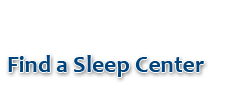| |
Have trouble sleeping? You're not alone. Find out more about the many sleep disorders that affect millions of people on a daily basis. If you are experiencing symptoms of these disorders, you should contact your physician or a SleepHealth representative at 800-381-6954 ext 6. Check out these helpful tips.
There are over 84 disorders. Here is a list of the most common.
In people who have sleep apnea (also referred to as sleep-disordered breathing), breathing briefly stops or becomes very shallow during sleep. This change is caused by intermittent blocking of the upper airway, usually when the soft tissue in the rear of the throat collapses and partially or completely closes the airway. Each pause in breathing typically lasts 10-120 seconds and may occur 20�30 times or more each sleeping hour. There are three forms of sleep apnea: central (CSA), obstructive (OSA), and complex or mixed sleep apnea (i.e., a combination of central and obstructive).
Central Sleep Apnea is when you repeatedly stop breathing during sleep because the brain temporarily stops sending signals to the muscles that control breathing. Central sleep apnea often occurs in people who have certain medical conditions. For example, it can develop in persons who have life-threatening problems with the brainstem, which controls breathing. Persons with central sleep apnea have episodes of disrupted breathing during sleep. Other symptoms may include Chronic fatigue, daytime sleepiness, morning headaches, and restless sleep.
Obstructive Sleep Apnea is the most common category of sleep-disordered breathing. The muscle tone of the body ordinarily relaxes during sleep, and at the level of the throat the human airway is composed of collapsible walls of soft tissue which can obstruct breathing during sleep. Common symptoms include loud snoring, restless sleep, and sleepiness during the daytime. A person who has obstructive sleep apnea often is not aware of the apnea episodes during the night. Often, family members witness the periods of apnea. He/she usually begins snoring heavily soon after falling asleep. Often the snoring gets louder. The snoring is then interrupted by a long silent period during which there is no breathing. This is followed by a loud snort and gasp, as the person attempts to breathe. This pattern repeats several times during the night. Many people wake up unrefreshed in the morning and feel sleepy or drowsy throughout the day. This is called excessive daytime sleepiness (EDS).
Learn more.
Continuous positive airway pressure (CPAP) is the most effective treatment for sleep apnea in adults. A CPAP machine uses mild air pressure to keep your airways open while you sleep. The machine delivers air to your airways through a specially designed nasal mask. The mask does not breathe for you; the flow of air creates increased pressure to keep the airways in your nose and mouth more open while you sleep. The air pressure is adjusted so that it is just enough to stop your airways from briefly becoming too small during sleep. The pressure is constant and continuous. Sleep apnea will return if CPAP is stopped or if it is used incorrectly. Learn more. For more information about CPAP and supplies, call SleepHealth at 800-381-6954 ext. 1.
Snoring is caused by a narrowing or partial blockage of the airways at the back of your mouth, throat, or nose. This obstruction results in increased air turbulence when breathing in, causing the soft tissues in your upper airways to vibrate. The end result is a noisy snore that can disrupt the sleep of your bed partner. This narrowing of the airways is typically caused by the soft palate, tongue, and throat relaxing while you sleep, but allergies or sinus problems also can contribute to a narrowing of the airways, as can being over�weight and having extra soft tissue around your upper airways.
Insomnia is defined as having trouble falling asleep or staying asleep, or as having dissatisfying sleep despite having ample opportunity to sleep. Chronic insomnia is defined as having symptoms at least 3 nights per week for more than 1 month. Learn more.
Restless legs syndrome (RLS) causes an unpleasant prickling or tingling in the legs, especially in the calves, that is relieved by moving or massaging them. People who have RLS feel a need to stretch
or move their legs to get rid of the uncomfortable or painful feelings. Learn more.
In some people, the walking, talking, and other body functions normally suppressed during sleep occur during certain sleep stages. Alternatively, the paralysis or vivid images usually experienced during dreaming may persist after awakening.
These occurrences are collectively known as parasomnias and include:
- confusional arousals (a mixed state of being both asleep and awake),
- sleep talking,
- sleep walking,
- night terrors,
- sleep paralysis, and
- REM sleep behavior disorder (acting out dreams).
Most of these disorders�such as confusional arousals, sleep walking, and night terrors are more common in children, who tend to outgrow them once they become adults.
Narcolepsy�s main symptom is extreme and overwhelming daytime sleepiness, even after adequate nighttime sleep. In addition, nighttime sleep may be fragmented by frequent awakenings. People who have narcolepsy often fall asleep at inappropriate times and places. Learn more.
For trauma survivors, nightmares are a common problem. Along with flashbacks and unwanted memories, nightmares are one of the ways in which a trauma survivor may relive the trauma for months or years after the event. Learn more.
Shift work sleep disorder is a circadian rhythm sleep disorder characterized by insomnia and excessive sleepiness affecting people whose work hours overlap with the typical sleep period. There are numerous shift work schedules, and they may be permanent, intermittent, or rotating; consequently, the manifestations of SWSD are quite variable.
|





